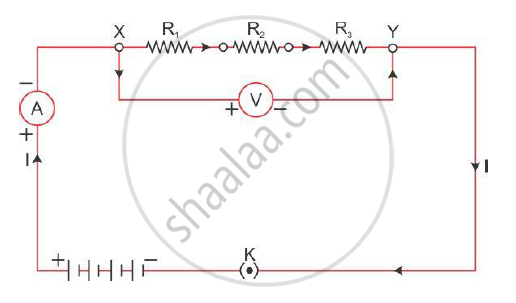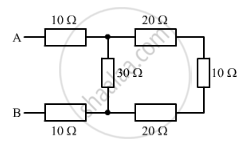Advertisements
Advertisements
प्रश्न
Find the expression for resistors connected in series.
उत्तर
When two or more resistors are joined from end to end, the resistances are connected in series.

The current in series remains the same across all the resistors.
The potential difference is the sum of potential differences across all the individual resistors.
V = V1 + V2 + V3 … (1)
Let I be the current in the circuit.
On applying Ohm’s law to the entire circuit, we get
V = IRs … (2)
Here, Rs is the combined resistance of the circuit.
Now, applying Ohm’s law to individual resistances, we get
V1 = IR1
V2 = IR2
V3 = IR3 ......(3)
From equations (1), (2) and (3), we get
IRs = IR1 + IR2 + IR3
∴ Rs = R1 + R2 + R3
Here, Rs is the resultant resistance. Thus, the resultant resistance of a series combination of resistors is the sum of individual resistances.
The resultant resistance is greater than all the resistances.
APPEARS IN
संबंधित प्रश्न
In series combination which remains constant?
(a) Voltage
(b) Current
(c) Both current and voltage
(d) Both are variables
(i) Two sets A and B, of three bulbs each, are glowing in two separate rooms. When one of the bulbs in set A is fused, the other two bulbs also cease to glow. But in set B, when one bulb fuses, the other two bulbs continue to glow. Explain why this phenomenon occurs.
(ii) Why do we prefer arrangements of Set B for house circuiting?
Give one example to show how the resistance depends on the nature of material of the conductor.
Calculate the resistance of an aluminium cable of length 10 km and diameter 2.0 mm if the resistivity of aluminium is 27 × 10−8 Ωm.
Give the law of combination of resistances in series.
The diagram below shows part of a circuit:

If this arrangement of three resistors was to be replaced by a single resistor, its resistance should be:
(a) 9 Ω
(b) 4 Ω
(c) 6 Ω
(d) 18 Ω

You are supplied with a number of 100 Ω resistors. How could you combine some of these resistors to make a 250 Ω resistor?
State the order of resistivity of (i) a metal, (ii) a semiconductor and (iii) an insulator.
State how are the two resistors joined with a battery when same current flows in each resistor.
What potential difference is needed to drive a current o f 1 A through a 5 Ω resistor?
What is the equivalent resistance between A and B in the given circuit (Fig?)

Choose the correct option from given alternative:
Two bulbs of 100 W and 40 W are connected in series. The current through the 100 W bulb is 1A. The current through the 40W bulb will be:
Write an expression for calculating electrical power in terms of current and resistance.
You are provided with three resistors of resistance 1.0 Ω, 2.0 Ω and 3.0 Ω How would you connect them to obtain the total effective resistance 1.5 Ω? Draw diagram of the arrangement and check it by calculations.
Calculate the equivalent resistance between P and Q from the following diagram:
Six equal resistors of 1 ohm each are connected to form the sides of a hexagon ABCDEF. Calculate the resistance offered by the combination if the current enters at A and leaves it at D.
Calculate the quantity of heat that will be produced in a coil of resistance 75 Ω if a current of 2A is passed through it for 2 minutes.
In an electrical circuit, two resistors of 2 Ω and 4 Ω respectively are connected in series to a 6 V battery. The heat dissipated by the 4 Ω resistor in 5 s will be ______.
When a 4 Ω resistor is connected across the terminals of a 2 V battery, the number of coulombs passing through the resistor per second is:
